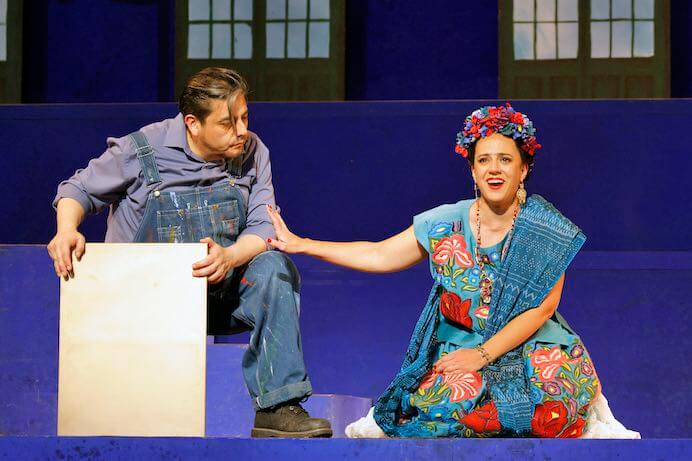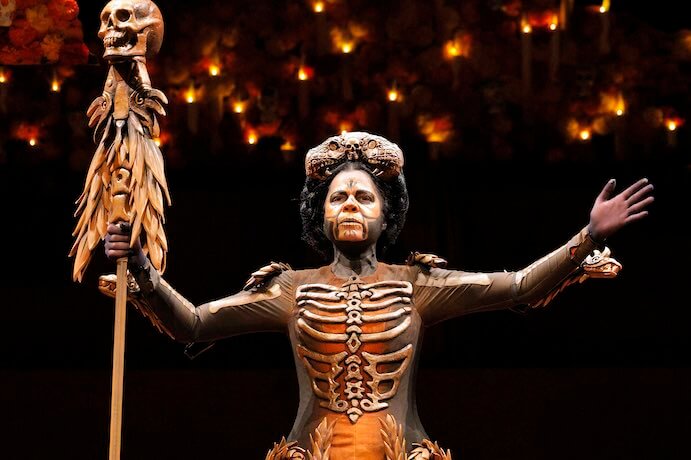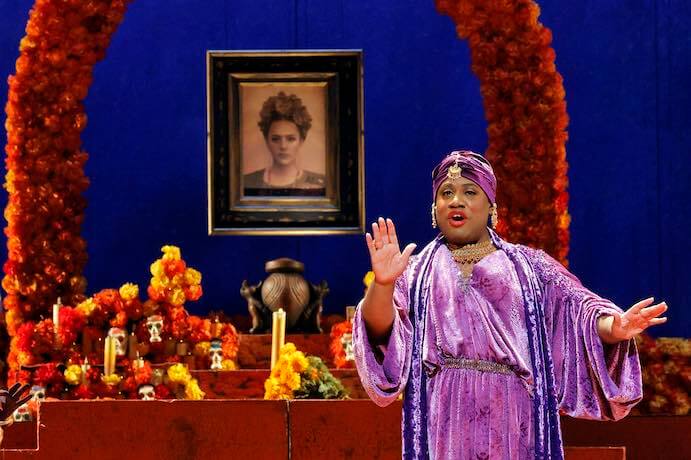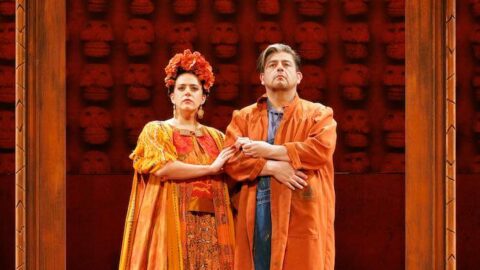In their debut opera, El Último Sueño de Frida y Diego, Grammy Award-winning composer Gabriela Lena Frank and Pulitzer Prize-winning playwright Nilo Cruz unravel the complexities of physical and emotional pain, love, and permanence within the marriage of famed Mexican painters Frida Kahlo and Diego Rivera. Focusing on the couple’s reunion on el Día de los Muertos (The Day of the Dead) — a Mexican holiday for paying respect and celebrating the lives of loved ones who have passed away — Frida y Diego breathes life into the stories of two artists known for capturing stillness. The plucky score, and Cruz’s libretto — laced with innocent humor — plunges into dark, hellish territory at a moment’s notice, encapsulated by a gilded picture frame affixed to the stage’s perimeter.
The opera, which had prior debuts at the San Diego and San Francisco operas before coming to Los Angeles on Nov. 18, is a cultural celebration especially fitting for the Berkeley-born composer’s home state. California has the highest population of Latin people in the United States, and the opera has steeped itself in the communities most invested in its impact.
At opening night of the LA Opera presentation, the buzz around this exciting new show was palpable, and the vibrancy of Kahlo and Rivera’s story spilled out beyond the stage. Many people came dressed in huipiles (a tunic-like garment often worn by Indigenous women in Mexico and Central America) and other traditional Mexican attire, while some even donned Kahlo’s trademark braided crown and floral headpiece. Before the program began, concertgoers lined up to take pictures with two women adorned in traditional Mexican dresses and skull face paint, or in front of a sprawling altar, designed by Oaxacan-American artist Aldo Cruz, that was overflowing with red, orange, and yellow flowers.

In the opening scene, Diego Rivera (baritone Alfredo Daza) stands over his wife’s grave on Día de los Muertos in 1957. His cries for her to come visit him in the world of the living are swept up in the cinematic score, led by Resident Conductor Lina González-Granados. Ascending dissonant string harmonies paint his grief and longing.
The titular characters start off a world apart — a sick and aging Diego yearns to close that gap, while Frida (mezzo-soprano Daniela Mack) is vehemently opposed to granting his wish. Twinkling lights and floral arrangements that were resting on the floor are suspended in mid-air to transform the set into the “underworld,” where Frida and others who have died are governed by the strict and villain-esque Catrina (soprano Ana María Martínez). The orchestra, resting firmly in lower timbres, peppers Catrina’s scenes with an understated spookiness, while brightness in the trumpets and upper woodwinds occasionally emerge to accentuate a punchline.

When given the opportunity to return to Diego, Frida’s steadfast refusal is puzzling at first. But implied infidelity and marital strife (the couple divorced after 10 years, then remarried each other the following year) sheds some light on Frida’s impenetrable disinterest in reuniting with her husband, if only for the one day she is allowed to. But Frida’s piercing cry of “¡agonía!” (agony), punctuated by raucous and sorrowful orchestration, uncovers her most significant aversion to the real world. After being impaled by a handrail in a bus accident in her youth, Frida was left with painful injuries, and crimson ribbons were pulled from Mack’s waist in various directions to depict the lasting wounds. The physical and emotional turmoil she endured during her life makes a return to the land of the living unappealing, even at the behest of her husband, who is unknowingly close to his own demise.
Frida is eventually persuaded to return by fellow underworld dweller Leonardo (Key’mon W. Murrah). While the character’s function is little more than a blip in Frida’s journey, Murrah’s pristine countertenor made his every appearance a delight, along with the romantic string and clarinet melodies that accompanied him.

Upon her return, Frida is forbidden to touch any living person or the excruciating pain from her accident will resume — one of Catrina’s conditions for temporarily releasing Frida from the underworld. This touch barrier further enforces a looming disconnect between Frida and Diego that is never explicitly addressed. Diego had been wracked with anguish over Frida’s absence, while Frida only agreed to return to the world in hopes of reviving her art. When she discovers she is unable to paint a portrait of herself, her anger ripples through the orchestra in percussive col legno strikes. In the most climactic points of her solos, Mack’s voice popped out with marvelous clarity.
A heat-of-the-moment embrace with Diego brings a wave of pain, but also restores her ability to paint her own image freely. In the opera, the absence of Frida’s pain also means the absence of what brings her the most contentment. Her hope of existing in the world – of living without pain, even for a day – proves attainable only at a cost.
Initially, the opera’s narrative is a bit elusive, since the relationship between the titular characters is more disjunct than expected. But in the spirit of el Día de los Muertos, El Último Sueño de Frida y Diego reaches across barriers. Gabriela Lena Frank and Nilo Cruz have reinvigorated historical figures who, for some, may only evoke a vague familiarity. Dynamic sets and costumes bring their art and culture to the present day, and the audience completed the cycle of connectivity with their own participation.
I CARE IF YOU LISTEN is an editorially-independent program of the American Composers Forum, funded with generous donor and institutional support. Opinions expressed are solely those of the author and may not represent the views of ICIYL or ACF.
A gift to ACF helps support the work of ICIYL. For more on ACF, visit the “At ACF” section or composersforum.org.
























